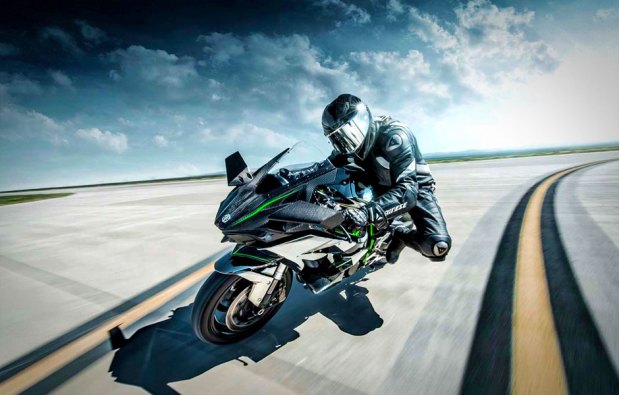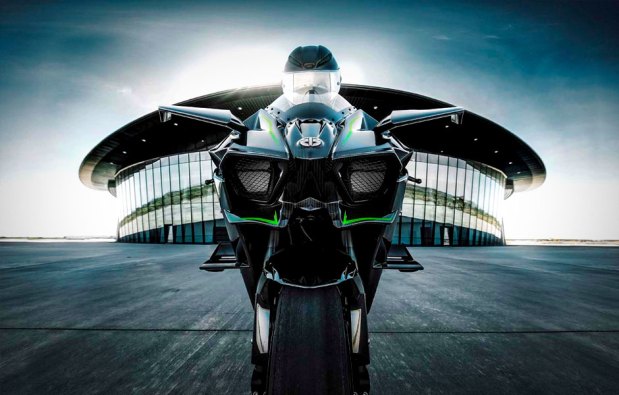Back in September, after a long run of rumors and teases that had the motorcycle press and speed freaks (the velocity kind) in a tizzy, Kawasaki pulled back the curtain on the H2R, a supercharged sport bike packing an astounding 300 brake horsepower – a good 100+ ponies more than pretty much anything else you can buy. A gigantic asterisk was also revealed: the H2R was a track-only bike and was not street legal.
Of course, that just set the stage for putting the motorcycle press and speed freaks in a second tizzy as they waited for the other tire to drop on the street-legal version of the H2R, called the H2. When it was finally revealed, super-charger intact but detuned to some degree, all everyone really wanted to know is: how fast will it go?
That seminal inquiry has been Question One since Gottlieb Daimler first fitted an internal combustion engine to a rickety wooden creation in the late 1800s. Once the little engine began filling the air with oil smoke and noise, Herr Daimler and whoever else was twisting wrenches most certainly took turns hopping aboard and seeing what she could do. Could it outrun a horse? Eh, probably not, but it beat walking.
Refinement to the simple concept of fitting an engine to a bicycle began in earnest soon afterward, with Indian coming online in 1901 and Harley-Davidson getting started in 1903, among dozens of other bike makers. Competition pushed design forward and racing pushed speeds ever higher; horses were out of the game in short order.

The Americans, Brits, Italians and Germans traded speed records and trophies for decades, but for the most part, consumers could rarely buy a bike that could top 100mph right off the showroom floor. That changed in a hurry when the Japanese bike makers got serious about speed in the 1960s, culminating in 1969 with the Honda CB750, which featured an air-cooled 77 horsepower inline 750cc four that could reliably and repeatedly hit 125mph or so by simply turning the throttle to the stop in 5th gear, no special skills or tuning magic required.
Kawasaki, pretty much a high-speed boutique maker compared to Honda’s goliath, answered in 1972 with the H2 Mach IV, a 750cc 3-cylinder two-stroke speed machine with woeful handling that quickly earned the nickname “widowmaker.” They hit again in 1973 with the KZ900, a 903cc inline four that was a beast of a machine and upped the ante with dual-overhead cams and even more power. Suddenly, it was game on in Japan.
The rapid pace of development there would temporarily bury the British bike industry as Triumph, Norton, BSA and others all turned out the lights. The Germans held fast (well, not really) and the Italians soldiered on, focusing more on style and handling than outright velocity. But that would eventually change.
Like a biblical lineage, the Honda CB750 begat the CB900, then the CB1100F. The KZ900 spawned the KZ1000, KZ1100, GPZ750 Turbo, GPz750 and 900 Ninja (the “Top Gun” bikes), and eventually the ZX series of sport bikes, culminating in the ZX-11D, a somewhat portly land missile that could touch 174 miles an hour given enough straight road. Along the way, Suzuki mixed in light weight, good handling and big power with the GSX-R series and Honda was still game with the CBR line, of which the CBR1000 was capable of 150mph or better. Along the way, fuel injection and other modern tech began to replace carburetors and other outdated systems. Speeds kept rising.

Then, in 1997, Suzuki unleashed the Hayabusa, a wind-tunnel sculpted 1300cc anomaly that got everyone’s attention when motorcycle magazines consistently posted top speeds in excess of 190mph, with Cycle World documenting 194mph on what Suzuki insisted was a perfectly stock bike. They immediately disappeared from showrooms at a heavy premium.
And then it all ended.
Bureaucrats in Europe, concerned over what they rightfully saw as a quickly escalating race to the 200mph mark, called a timeout by threatening to heavily tax any bike that could exceed 186 mph, or 300kph. It was called a “gentleman’s agreement” by bike makers but riders called it numerous other derisive names, including “coward’s agreement.”
With the top speed war on pause, bike makers focused on other aspects of performance, namely handling and engine management technologies. Post-1997 sport bikes could often easily hit 186mph, but built-in electronic nannies now kept the peace. Testing for top speed became a moot point, the question simply became how quickly the newest model could make it to the new digital wall.
Then, the H2R.
When news of the supercharged track machine was finally confirmed, Question One returned. The answer? Still not precisely known, but many pundits say their math points to a top speed of about 250mph – on a track. With modern supercars rapidly closing in on 300 mph, 250 doesn’t have quite the glamour it may have years ago, but keep in mind this is from a bike that has an MSRP of 50 grand and not the better part of a million dollars. Sure, they’re all sold out now, but the motorcycling press and speed freaks are now waiting to see if the detuned street-legal H2 with adhere to the 186mph limit – or blow right through it.
Because while the bureaucrats were sleeping, everyone has been dialing up the power, dialing back the weight and stuffing modern bikes with enough technology to shame most high-end sport cars. Crushers like the Ducati 1299 Pinagale, the BMW1200RR and now the Kawasaki H2 are lying in wait, 200+ horsepower engines at the ready.
Will the H2 be the first halo bike to finally give 186 the finger? Stay tuned, because if it does, 200mph for $30,000 or less could be as close as turning an ignition key.


